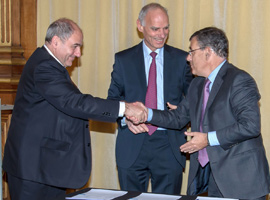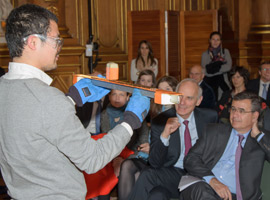
On March 20 at the Hôtel de Ville in Paris, the École Supérieure of Industrial Physics and Chemistry of the City of Paris, the company Nexans and the ESPCI Georges Charpak Endowment Fund signed an agreement to create a partnership promoting excellence in research. At the heart of the project lies the science and technology of the transport of energy.
Signed by Jean-Louis Missika, President of ESPCI ParisTech and deputy to the Mayor of Paris responsible for innovation, research and universities, Frédéric Vincent, President and Director General of Nexans, and Jacques Lewiner, President of the ESPCI Georges Charpak Endowment Fund, this agreement establishes cooperation in science and innovation between Nexans, world leader in the field of advanced cables, and ESPCI ParisTech, ranked as the foremost French engineering school by the Shanghai Classification.
Jean-Louis Missika was pleased to welcome the move by Nexans as “a pioneering enterprise among the partners of ESPCI ParisTech, a school whose research can provide a crucial competitive advantage for the company”.
Frédéric Vincent indicated that “Nexans needed to develop technical expertise; this agreement is the best way of achieving that in the field of nanotechnology, polymers and high voltage”.
About Nexans
With energy at the basis of its development, Nexans, worldwide expert in the cable industry, offers an extensive range of cables and cabling solutions. The Group is a global player in the energy transmission and distribution, industry and building markets. Nexans addresses a wide series of market segments: from energy and telecom networks to energy resources (wind turbines, photovoltaic, oil and gas, and mining) to transportation (shipbuilding, aerospace, automotive and automation, and railways). Nexans holds an unique expertise in the field of superconducting cables.
An ambitious scientific project
There are a number of research fields at the heart of the joint venture. These include, under the leadership of Stéphane Holé, electrical insulation and more particularly the study of insulators and their interfaces for high-voltage devices, and methods of characterizing insulating material by measuring the space charge distribution.
Other areas are: superconductor materials and new polymer materials
Three presentations gave a foretaste of the variety of innovative research carried out by ESPCI ParisTech:
• the vitrimer, a material developed by Ludwik Leibler, associate professor at ESPCI ParisTech, director of the Laboratory for Soft Matter and Chemistry (MMC) and recipient of the CNRS Medal for Innovation in 2013;
• ultrafast medical imaging, developed by Mickaël Tanter, director of research at the Institut Langevin of ESPCI ParisTech;

• superconductivity and Meissner effect levitation, studied by Jérôme Lesueur, professor and director of the Laboratory of Physics and Materials Study (LPEM).
During the ceremony, the engineering students Aurélien Baelde and Kejian Wang gave a demonstration of superconductivity using a levitating train made by them at the Langevinium, the School’s HackLab, of which they are the cofounders with their colleague Guillaume Chatté. There remarkable demonstration captured the attention of the public and greatly contributed to the success of the day.







